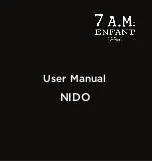
30
|
6.2.2 Water Components
6.2.2.1 Water Controls
Confirm that the incoming water supply isolation valve is operational. If the isolation valve is in a location accessible by
the public ensure that the valve can be locked open and closed.
6.2.2.2 Water Connection Visual Inspection
The incoming water supply is to be visually inspected for damage and leaks. If visual damage is evident the supply is to
be isolated and location of the leak to be identified and fixed.
6.2.2.3 Water Isolation Fitted and in Good Working Condition
The water isolation ball valve is to be examined to make sure that it is present and in good working condition.
6.2.2.4 Water Supply Pressure
The water supply pressure is to be read at the entry to the unit and recorded.
6.2.2.5 Float Valve Operation
Check that the float valve allows for water to enter the reservoir and is set so that flow stops when the water level is
5 - 10mm below the overflow. Adjust if necessary.
6.2.2.6 Overflow and Drainage
Push the float valve down allowing excessive water into the reservoir until water flows into the overflow drain. Confirm
the drain takes away all excess water.
6.2.2.7 Automatic Drain Valve
Refer to Automatic Drain Manual and confirm operation.
6.2.2.8 Bleed Valve
Confirm that the bleed valve is set to the correct rate. Refer to
Table 4: Bleed Off Rate
.Note:- Formation of salt deposit
in cooler pads indicates insufficient bleed off. If there are white deposits in the pads or tank the bleed rate needs to be
increased.
6.2.2.9 Cooling Pads
The cooling pads should be periodically cleaned. Once the pads have been removed from the unit they can be cleaned
using a spray nozzle on a garden hose with a moderate pressure.
Do not
use a high-pressure hose. At this time the
cooler cabinet should be inspected and cleaned.
Cooling pads should be periodically changed, the frequency being determined by the rapidity with which dirt, alkali and
other foreign matter accumulates in the pads to the extent that cooling efficiency is impaired. The need for changing
pads will vary with the locality. If in very good condition, pads may be washed to clean away dust etc, but if pads
appear aged or badly fouled, then replace. In localities where there is an excess of lime and alkali, the reservoir pan
should be cleaned out every 60 days. If the water is all re-circulated this clean out must be done more frequently. This
will also remove dirt which has been washed out of the filter pads.
6.2.3 Casing Components
6.2.3.1 Weatherproof Casing Condition
Check the weatherproof casing for signs of damage, corrosion and leaks.
6.2.3.2 Water Carry Over
As pads become blocked the open area decreases consequently increasing air velocity across the pads which leads
to excessive water carry over from the pads onto the internal components. The effect can lead to premature bearing
failure and corrosion within the unit and ductwork. Pads are to be cleaned and/or replaced and confirm saturation rate
of pads.
6.2.3.3 Duct Condition
Visually inspect the ductwork connection into the unit for damage. When the unit is operating inspect the ductwork for
leaks where visible.
MAINTENANCE
















































